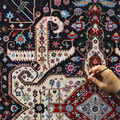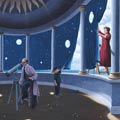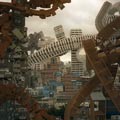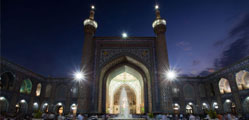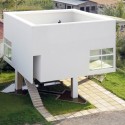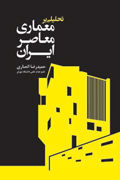
© Kiến Việt
Architects: Hoàng Thúc Hào, Nguyễn Duy Thanh
Architects and invester: 1+1>2 Group
Location: Suoi Re village, Luong Son, Hoa Binh province, Vietnam
Project year: 2010
Photographs: Courtesy of Kiến Việt

© Kiến Việt
All year round most villagers go to the towns and cities to earn for their living. The rest stay home and continue to grow rice very hard. The struggle for a better life makes them exhausted. They don’t have any time to care about education, cultural and spiritual developments of their own as well as their children’s.

© Kiến Việt
Besides, the increase gap between urban and rural areas due to the urbanization and the economic development has made the social relationship increasingly loose and be in danger of disintegration. In the remote villages, the spaces for communal activities, kindergartens, health care stations, post offices, libraries seem to be luxuries. If there is any of those, it is very temporary, formalistic and identity.
Our multi-functional community house was created in this context. It has good Feng Shui, leans on mountains, avoids storms, flash floods and faces towards the valley.

© Kiến Việt
The overall spatial structure is organized in chain. Front space is the open courtyard, where holds the outdoor activities. The main living space lies in the middle part, consisting of two floors. Upstairs is a kindergarten combining with library, meeting areas …The function interlock flexibly. Wide veranda with lawns act as a green cushion with high visibility. Ground floor is designed to fit the concave slopes, utilizing geothermal. It can avoid east northern monsoon (which is very dry and cold in the winter) and collect east-southern monsoon ̣(that makes the house warm in winter and cool in summer). Space leads to the mountain and bamboo forest. On the ground floor, villagers gather, doing the sidelines. Especialy, young children and the elderly may be staying here during the very cold or hot times of the years…

first floor plan
The idea of having a convection wind tunnel, the ellipsoid open space, the grass steps, slopes taper, exposure roof make all those connect with the front and the back, the interior and the exterior, the upstairs and the downstairs, creating a continuous chain of open space. The majority Kinh people and the minority Muong people have lived in harmony in the land of acculturation for a long time. Therefore, morphological of the house has inherited the structure of five-room traditional house of Kinh people as well as traditional stilt house of Muong people.

© Kiến Việt
Structure idea is simple, economical, utilizing the availability of local materials and following this principle: unity in diversity contrast. Ground floor is made of rugged-stone wall, bamboo doors, fine-bamboo ceiling those make people feel warm and balance in the house. Upstairs is made of brown and smooth rammed-soil wall with heavy stones beneath, bamboo frames, palm leaves roof. Solar cell system, filter rainwater collection tanks, geothermal, monsoon, power-saving LEDs, five-compartment septic tanks which is not polluted. They are the test solutions of green architecture, energy efficient and friendly environment .

strategy saving energy
The villagers build their own homes. They will enjoy the efficiency of space and the utility of each element: stone, earth, bamboo, leaves, air, wind, sun, jungle sounds. Hopefully once this work is carried out, It will strengthen the bonds of community, contributing to the consolidation, maintenance and development of regional identity. This is a direction, can take the experience and replicate the model for rural midland area.




